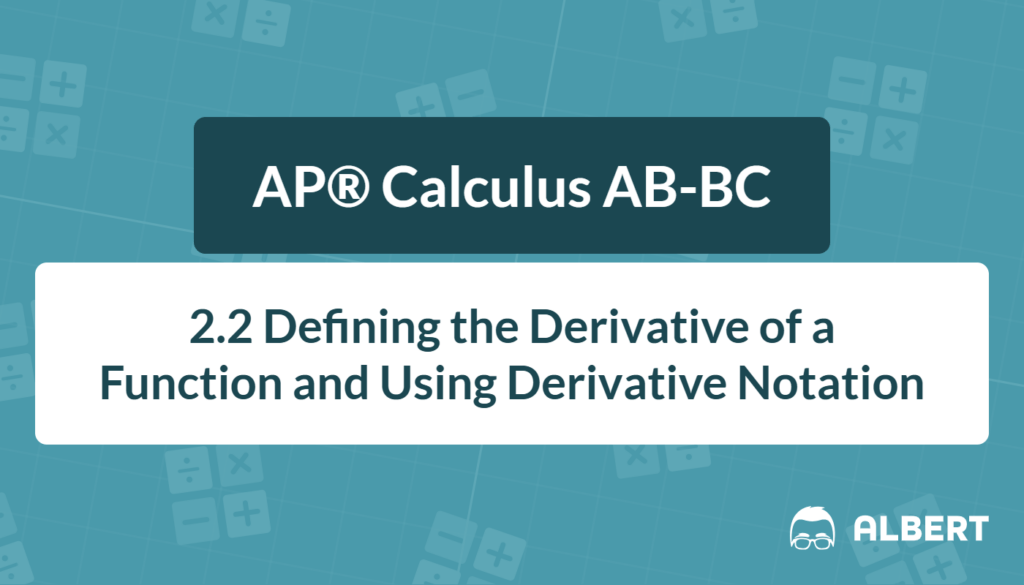Everyday life is packed with rapid changes—car speedometers, stock growth rates, and profit margins adjust in real time. Therefore, calculus steps in to measure those changes precisely. Understanding the derivative, its notation, and its link to the slope of the tangent line builds the foundation for nearly every AP® Calculus topic.
What We Review
Building the Core Idea: What Is a Derivative?
Intuitive Picture
The derivative is the instantaneous rate of change of a function. Meanwhile, the average rate of change uses two points on a curve, forming a secant line. However, the derivative zooms in to a single point, giving the slope of the tangent line instead.
Mini-Analogy: Zooming In
Imagine pinching-to-zoom on a curved graph until one tiny piece looks straight. At that micro-level, the curve behaves like a straight line. The slope of that “almost straight” segment is the derivative.
The Limit Definition of a Derivative
The formal definition is \displaystyle f'(x)=\lim_{h\to 0}\frac{f(x+h)-f(x)}{h}.
Worked Example #1
Find f'(x) for f(x)=x^{2}-3x.
Solution
- Write the difference quotient: \displaystyle \frac{(x+h)^{2}-3(x+h)-\bigl(x^{2}-3x\bigr)}{h}
- Expand numerator: \displaystyle \frac{x^{2}+2xh+h^{2}-3x-3h-x^{2}+3x}{h}
- Simplify: \displaystyle \frac{2xh+h^{2}-3h}{h}
- Factor out h: \displaystyle \frac{h(2x+h-3)}{h}=2x+h-3
- Take the limit as h\to 0: \displaystyle f'(x)=2x-3.
Key Takeaways
Therefore, if the limit fails to exist or is infinite, the derivative at that point does not exist.
Derivative Notation
Common Symbols
- f'(x)
- y'
- \dfrac{dy}{dx}
- \dfrac{d}{dx}[f(x)]
Reading Aloud
- “f prime of x”
- “y prime”
- “dee-y dee-x”
- “dee by dee-x of f of x”
Worked Example #2
Given y=\sqrt{x}, the derivative is y'=\dfrac{1}{2\sqrt{x}}. The same result may be written as
f'(x)=\dfrac{1}{2\sqrt{x}} or \dfrac{dy}{dx}=\dfrac{1}{2\sqrt{x}}.Pro Tip
Choose derivative notation that matches the question format. For graphs, f'(a) is efficient. However, tables often favor \dfrac{dy}{dx}.
Four Representations of a Derivative (CHA-2.B.4)
Graphical Representation
Picture a parabola y=x^{2}. Draw a tangent at x=1. The slope visually appears about 2. (See Example #3.)
Numerical (Tabular) Representation
Make a small-h table for f(x)=x^{2} at x=1.
| h | Average rate \dfrac{f(1+h)-f(1)}{h} |
| 0.1 | 2.1 |
| 0.01 | 2.01 |
| 0.001 | 2.001 |
Therefore, the numbers approach 2, confirming the derivative.
Analytical (Symbolic) Representation
After mastering limits, rules like the Power Rule speed things up. For f(x)=x^{2}, directly write f'(x)=2x.
Verbal Representation
“Temperature is rising at 2 °C per minute” is a plain-English derivative.
Derivative at a Point = Slope of the Tangent Line (CHA-2.C.1)
Geometric Meaning
Zooming again, the tangent line touches the curve at one point and mimics its direction there. Its slope equals the derivative value.
Worked Example #4
For g(x)=\ln x at x=e:
- Use the known derivative rule: g'(x)=\dfrac{1}{x}.
- Therefore, g'(e)=\dfrac{1}{e}.
- The tangent line formula: \displaystyle y-g(e)=g'(e)(x-e) which simplifies to \displaystyle y-1=\dfrac{1}{e}(x-e).
Common Pitfalls
Students sometimes confuse the secant slope between two points with the slope of the tangent line at a single point. Always let h\to 0.
Putting It All Together: Mixed-Format AP-Style Example
A piecewise velocity graph shows a straight segment rising from 0 m/s to 10 m/s over 5 s, then a flat segment at 10 m/s.
Tasks
- Estimate the derivative at t=2\text{ s} from the graph.
- State units.
- Decide where the derivative fails to exist.
Solution
- The line through (0, 0) and (5, 10) has slope 2, so v'(2)\approx 2\text{ m/s}^2.
- Therefore, the units are meters per second squared (acceleration).
- At t=5\text{ s} the graph has a sharp corner; thus, the derivative (acceleration) does not exist there.
This example required switching among graphical, numerical (slope), and verbal interpretations—exactly the AP® style.
Quick Reference Chart: Essential Vocabulary
| Term | Definition or Key Feature |
| Derivative | The instantaneous rate of change; slope of the tangent line |
| Limit | The value a function approaches as the input nears some point |
| Tangent line | Straight line that touches a curve at one point and matches its slope there |
| \dfrac{dy}{dx} | Leibniz notation for the derivative of y with respect to x |
| Instantaneous rate of change | Value of the derivative at a single point |
| Secant line | Line through two points on a curve; gives an average rate of change |
| Power Rule | If f(x)=x^{n}, then f'(x)=nx^{n-1} |
Conclusion: Key Takeaways
Derivatives describe how quantities change at a specific instant. Moreover, mastering the limit definition and derivative notation unlocks deeper skills: graph analysis, motion problems, and optimization. Therefore, practice translating among graphical, numerical, analytical, and verbal views. With consistent effort, the slope of the tangent line will feel as natural as the slope of a straight line.
Sharpen Your Skills for AP® Calculus AB-BC
Are you preparing for the AP® Calculus exam? We’ve got you covered! Try our review articles designed to help you confidently tackle real-world math problems. You’ll find everything you need to succeed, from quick tips to detailed strategies. Start exploring now!
- 2.1 Defining Average and Instantaneous Rates of Change at a Point
- 2.3 Estimating Derivatives of a Function at a Point
Need help preparing for your AP® Calculus AB-BC exam?
Albert has hundreds of AP® Calculus AB-BC practice questions, free responses, and an AP® Calculus AB-BC practice test to try out.








